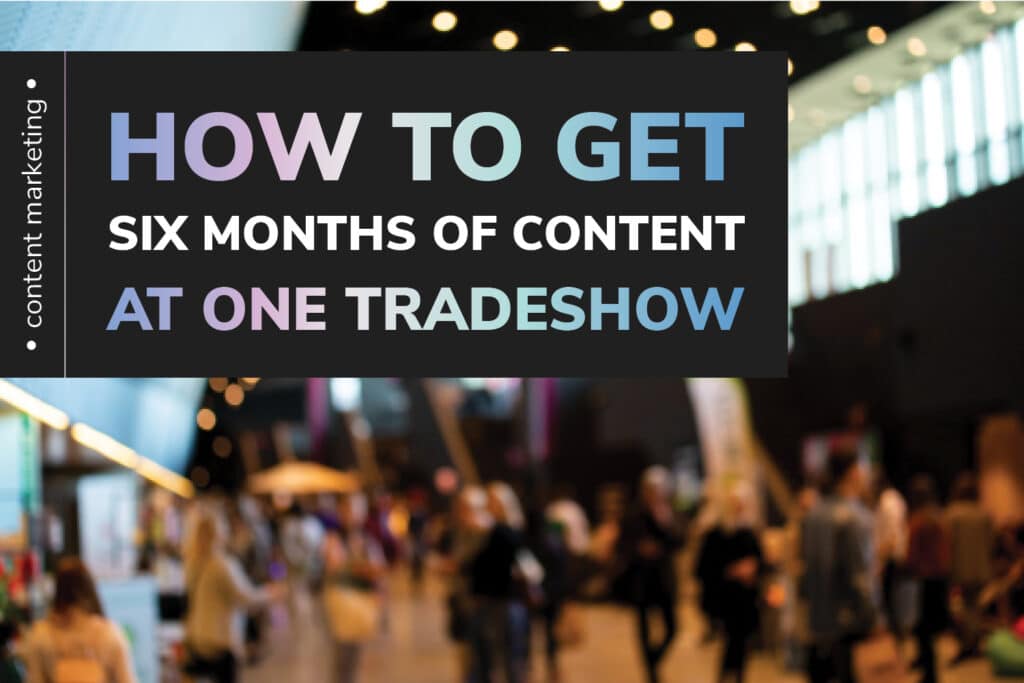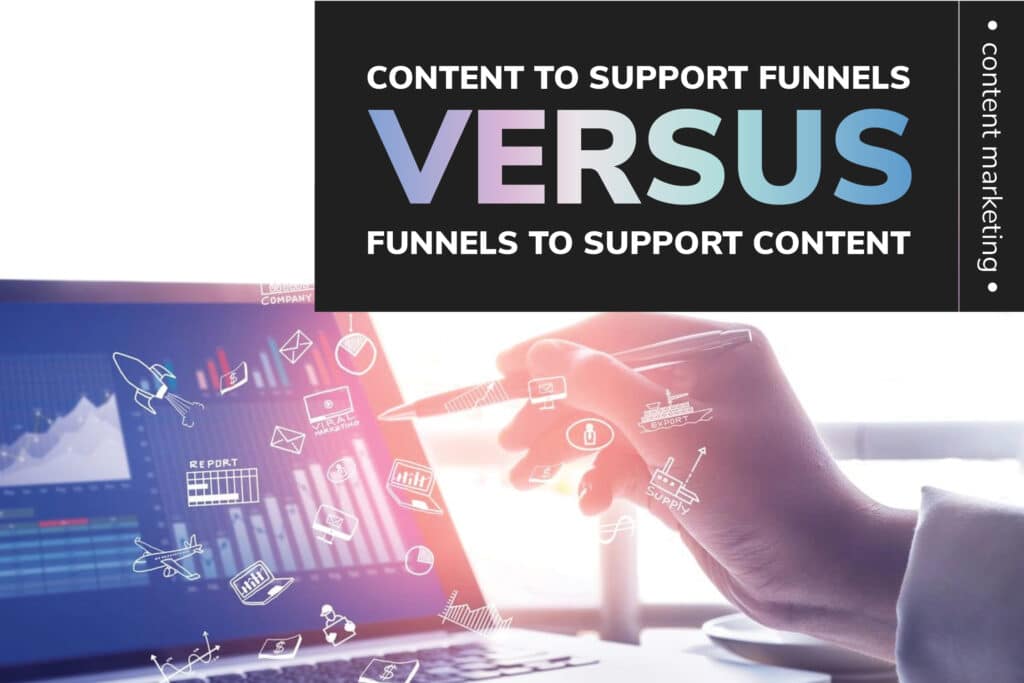Traditional marketing depends on ‘interrupting to pitch’ where we get you to stop what you are doing to hear our pitch.
Lead generation, or the top of the funnel, employed a variety of ‘interrupting to pitch’ techniques to get prospects into the funnel such as:
- Cold email campaigns from purchased lists;
- Cold calling by Sales Development Reps to a target list;
- Paid social ads such as Facebook that ‘interrupt’ the social experience.
Prospects that clicked on our email or paid social are sent to a landing page.
Content marketing, if used, offered downloadables in exchange for contact information. The idea was a little value add content and your potential customer gave you the right to sell to them.
Search Advertising
Google AdWords is different than cold outreach since the user has intent. They are actually looking for something. Assuming that you can find keywords that equate to interest in your particular product, AdWords can be a very effective way to advertise.
Since AdWords are an auction, each click can be very expensive depending on who you are bidding against.
Typically a click-through is sent to a landing page where we have the same issue as above. Offering something of value in exchange for an opt-in. The average page conversion rate, the percentage of clicks that give you their contact information, tends to be very low making the cost of acquiring a lead potentially very high. For example, assume your cost of a click is $2.69 (average across all industries) and your page conversion rate is 2%, your cost of a lead is $134.50. If you close 2% of these leads, your cost of acquisition would be $6,725.
Finding Your Customers Face-To-Face
Trade shows, the in-person equivalent of Google AdWords, often became the main source of leads for B2B companies since there is a good chance that your target customer is attending to explore specific solutions or vendor options.
In-person trade shows are one of the best ways to gain trust since as humans we rely on a variety of cues to decide if a person is trustworthy.
Trade shows can be very expensive so the cost per lead can be very high.
Cost aside, trade shows all but disappeared during COVID.
Without COVID restrictions, trade show attendance has increased dramatically. So why won’t things just return to normal? Simply put, companies that have developed successful hybrid strategies (a combination of digital and in-person) will have a competitive advantage.
Why There is No Going Back
Two trends that were well underway before COVID have accelerated and made it impossible to return to ‘normal’.
- Buyers, on average, want to get 90% of the information about a specific solution or vendor before they want to speak to the seller. They are not going to opt into your low-value infographic downloadable;
- 98-99% of modern B2B decision-makers ignore cold outreach.
There is no reason to believe that these trends will reverse, quite the opposite, it will only get harder to fill the top of your funnel with prospects using cold outreach or lightweight downloadables. Your cost of acquisition will continue to rise.
So what strategies have emerged that break through these trends?
What Strategies Have Successful Companies Discovered?
There are many examples of companies that have thrived during COVID for reasons such as:
- Remote workers became more efficient without the need to commute to work or travel for business;
- Teams became more agile because they had to solve workflow and decision-making processes in order to survive;
- Overall operating costs declined along with the cost of sales and marketing.
So what strategies have emerged as replacements for traditional cold outreach and lame website opt-ins?
Content That Educates
The term content strategy has been around for many years and yet most B2B marketing teams are still trying to take a shortcut.
Blogs are based on high-level keyword searches and don’t actually provide new information or insight.
Social posts suffer the same fate tending to be gimmicky rather than containing substance.
The problem is how do we create genuine, substantive content? Doing keyword research to find important topics that your audience cares about is only the start.
You need to research ideas and answers that help your potential customers solve their real problems.
The most effective way to do this is to think of content series, not one-offs. Like all good series, you start with a themes and then develop them into series.
An example of this strategy that works on two levels, is a partner-co-authored white paper series. With the participation of partners, the content is richer and more relevant to more of your potential audience.
And just as important, you bolster deepen the relationship with your partner instead of just asking them for leads or referrals.
And no, product sheets masquerading as white papers don’t work. Your content strategy needs to be motivated by a selfless intent to educate your buyer.
Stop Selling And Start A Conversation
Instead of interrupting to pitch, find ways to start a conversation in order to build credibility and trust. This goes hand in hand with the content strategy above.
Use social, such as LinkedIn to post helpful information and reach out to potential customers by posting helpful comments to their posts. Use Facebook and Instagram in the same way.
A good example of this strategy in practice is similar to an Account Based Marketing (ABM) approach. Traditional ABM starts by identifying a list of target accounts and the decision-makers within those accounts.
We start the same way but instead of spamming these individuals, we task our executives to start conversations with our target account buyers. For example, CEO to CEO, CFO to CFO, CMO to CMO, and so on.
Next, we provide value add content and a framework to create these interactions so we are not leaving it to chance. Authentic, frequent, and consistent are the most important attributes of this strategy.
Why Are These New Strategies So Hard
The main reason that the above content and conversation-based strategies fail is that they are long-term and take years to do properly.
The culture that goes with an MQL/SQL quantity approach will block this new approach.
The following is a step-by-step process to create a successful program.
- The top leadership team needs to be fully behind the strategy and lead by example.
- Set up an editorial team whose job is to define the message strategy and content pillars.
- Source thought leaders who will provide content – think video first.
- Build a repeatable process to support each piece of content. For example YouTube descriptions, Blog posts, social posts, partner distribution, and Ad campaigns.
- Build a framework for leadership, marketing, and sales to contribute to the program.
When your program is working properly you can expect your funnel to be very different. Along the lines of “I’ve been talking to a CEO about the problems that they are facing and they asked if somebody was available to take them through our approach.”
Instead of measuring MQLs and SQLs, you will be measuring the number and quality of new conversations.
Conclusion
B2B Sales and Marketing has shifted to educate instead of sell, building trust through social media, co-authored white papers, and avoiding SPAM and cold calling.
Companies need to adapt to two trends that were already well underway before COVID and have accelerated, making it impossible to return to normal.
Buyers now want to get 90% of the information about a specific solution or vendor before they want to speak to the seller, and 98-99% of modern B2B decision-makers ignore cold outreach.
Instead of interrupting to pitch, companies need to find ways to start a conversation to build credibility and trust, using social media platforms such as LinkedIn, Facebook, and Instagram. Successful companies are creating genuine, substantive content that is motivated by a selfless intent to educate the buyer, rather than trying to sell.
It is essential to create a content series that researches ideas and answers that help potential customers solve their real problems. Overall, companies that have developed successful hybrid strategies (a combination of digital and in-person) will have a competitive advantage as things won’t just return to normal.




